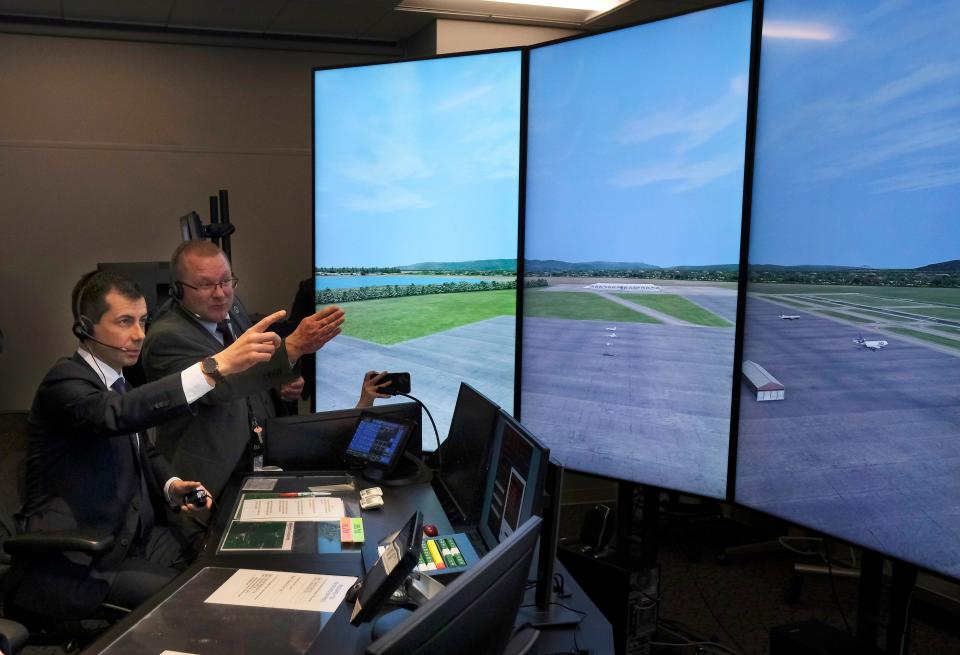Budget fight could derail air traffic controller training in Oklahoma, agency head warns
- Oops!Something went wrong.Please try again later.
The Federal Aviation Administration’s plan to accelerate the training of air traffic controllers in Oklahoma City would likely be derailed by budget cuts or even a budget stalemate in Congress, the head of the agency warned a key congressional subcommittee headed by Oklahoma Rep. Tom Cole.
Billy Nolen, the FAA’s acting administrator, said a budget freeze would mean the agency couldn’t hire enough air traffic controllers to meet the nation’s needs, while a cut of 20% would mean furloughs and layoffs.
“It would mean suspending training at our FAA academy” in Oklahoma City, Nolen told the Appropriations subcommittee that oversees transportation spending last week.

Cole, R-Moore, is the chairman of the subcommittee.
The FAA has a major presence in Oklahoma City, employing about 3,300 people, according to a 2021 study by the Oklahoma Department of Commerce. The academy at the Mike Monroney Aeronautical Center trains air traffic controllers for several countries and has been ramping up training for domestic controllers after being shut down for nearly a year because of the pandemic.
More: Biden administration wants to boost aviation sector training in OKC
U.S. Transportation Secretary Pete Buttigieg was in Oklahoma City in March to tour the center, which also includes programs geared toward commercial space transportation and hazardous materials safety.
Nolen said the FAA has hired 979 of the 1,500 controllers authorized this year. The FAA is asking for a budget bump of $117 million for the next fiscal year so it can hire 1,800 new controllers.
“The rapid return of air travel is a great indicator of the resiliency of the American economy, but it also makes accelerating our hiring push a top priority,” Nolen told the subcommittee. “This budget provides the investment necessary to ensure that a surge of new controllers can match this resurgence in air traffic.”
House Republicans approved a bill last week that would slow federal spending for the next 10 years, though they have not released a budget detailing specifics. The Senate, controlled by Democrats, is not expected to consider the House bill, and the White House has threatened a veto.
More: Buttigieg visits OKC to highlight focus on airspace safety, reliability
The most immediate concern about conflicting budget approaches is the debt ceiling, which is expected to be reached within a few months, and the prospect for default.
Cole, a veteran of many budget skirmishes, asked Nolen about the potential impact if no budget agreement could be reached and agencies were told to operate under a continuing resolution (CR) that left in place the funding levels and directives approved for the current year.
“Every appropriator on both sides of the aisle does not want to see that result,” Cole told Nolen. “And I’m quite sure you at the FAA don’t want to see that either.”
Nolen said, “A full-year CR would really cause harm at the FAA across multiple areas. It would likely lead to delays and cancellations. We would be forced to implement a hiring freeze. We would be unable to increase hiring of air traffic controllers to meet our standards. We also would be unable to deliver on accelerating the pace of modernization.”
Illinois Rep. Mike Quigley, the top Democrat on the subcommittee, asked what the consequences would be of cuts of 20% or more, a level that has not been proposed for the FAA.
“When we think about the kind of cuts that might either be anticipated or put forth, we are talking about having to furlough all FAA employees for up to 22 days,” Nolen said. “We are talking about the potential reduction in force of up to 10%, which is in excess of 4,000 FAA employees. It means immediate cuts in all of these critical systems. It would mean suspending training at our FAA academy … this path we’re on to getting more controllers out there to meet the demand that is back faster than ever.
More: Buttigieg visits OKC to highlight focus on airspace safety, reliability
“It would mean closing, shutting down service at 125 low-activity towers and over 250 federal contract towers.”
Republican Rep. John Rutherford, of Florida, asked whether it was even feasible to hire new controllers at the pace envisioned by the FAA, noting that only 60% of those who begin the training are ultimately certified.
Nolen said he did believe the goal could be achieved.
“We have sort of moved heaven and earth, if you will, and I’ve given that challenge to our team, both in the air traffic organization, in our finance department, and our folks who operate the academy in Oklahoma City. We feel like we’ve got a strong pathway to get there. So that’s just part of the equation.
“To mint a fully certified controller, he or she goes through the academy, they get through that training, they get out to the facility, they have to be fully certified on a facility-by-facility basis, and that’s really what takes up the bulk of the time. So, we’re looking to see how can we decrease the throughput from the time I start — get accepted to the FAA as a controller — to the time I come out the other side” as fully certified.
This article originally appeared on Oklahoman: FAA head warns budget fight could slow controller training in Oklahoma

